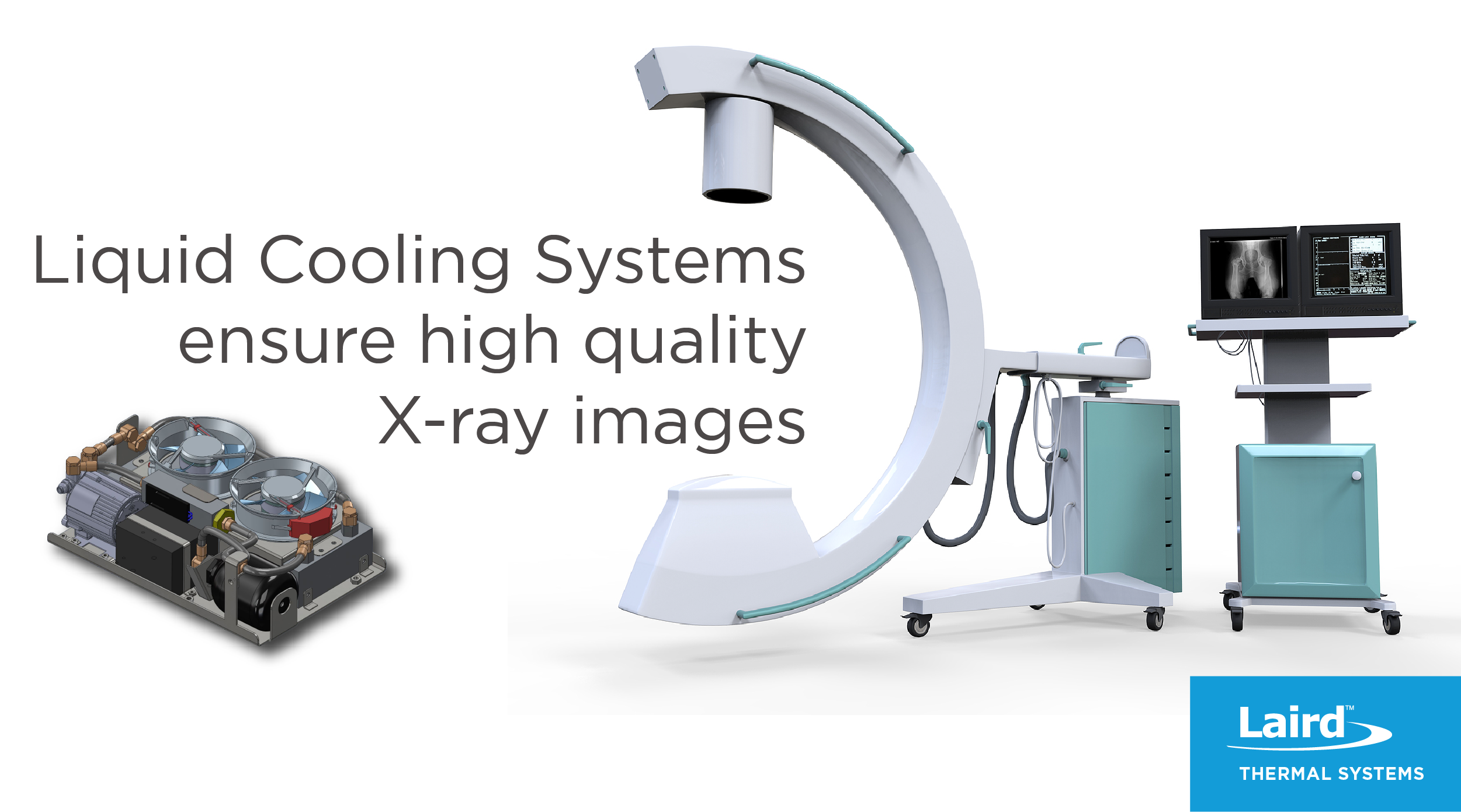Introduction
Designed to take pictures inside a patient’s body, medical X-ray imaging systems are a vital piece of detection equipment. Medical X-ray imaging equipment can be used to detect and diagnose a wide range of injuries or diseases. In X-ray-based imaging techniques, an X-ray beam is projected through a patient to a recording medium. The generation and projection of an X-ray beam is highly inefficient and produces a large amount of waste heat. The heat load can be as much as 5KW. Temperature stability within medical imaging systems is critical to enhance imaging performance, increase system reliability, and maximize equipment uptime. Medical imaging systems require conflicting requirements of increased heat pumping performance with lower power consumption. As a result, liquid cooling systems are often the preferred choice to move heat away from the X-ray tube to ensure quality images are produced. Thermal management systems that feature liquid cooling offer higher efficiencies than air-based heat transfer mechanisms. This translates into higher reliability, reduced field maintenance, greater system uptime and lower total cost of ownership.
Application Overview
Simply put, a medical X-ray system includes an X-ray generator, an X-ray tube and gantry, and a recording medium. To generate an X-ray beam, an electrode pair, an anode and a cathode, are inside of a vacuum tube that is typically made of glass. The cathode is usually a heated filament, while the anode is a flat disc made of tungsten.
In computed tomography (CT) X-Ray systems, the tube and the detector are both rotating around the body during the examination.The flat panel detector technique requires the CT scanner to take many scans of the body, which is then put together layer by layer to create the 3D image.

In CT-scanners, both the tube and detector rotate around the body during X-ray examination.
Often referred to as interventional imaging, C–arm X-ray machines create continuous, real time X-ray images of the movement of a body part, instrument, or contrast agent. C-arm X-ray machines use an image intensifier technology that delivers superior imaging quality compared to flat panel detector technology used by CT scanners. Image intensifier technology enables C-arm X-ray machines to be used for imaging during surgical, orthopedic, and emergency care procedures. Compared to CT scanners, C-arm machines require significantly less space in an often crowded operating room.
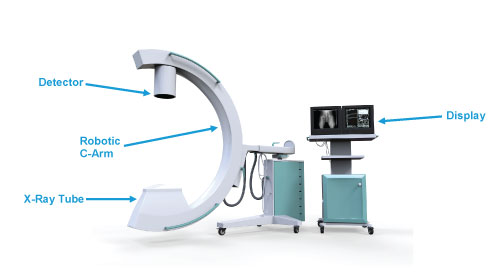
Key components of a C-arm X-ray Machine
Thermal Challenges
Medical X-ray manufacturers are tasked with developing new designs that increase scan speeds while improving image quality. Many manufacturers are working towards designing equipment that can scan entire organs in 4D. This can only be achieved by reducing thermal noise in the system to enhance imaging quality. Only a small portion of the energy generated by the system is emitted as X-rays, the balance is released as heat. X-ray systems have a heat load range of 1~5KW that must be efficiently dissipated. Temperature fluctuations not only impact image resolution, but also long-term operation of key components. The X-ray tube, and specifically the anode, must be cooled for optimized X-ray performance and a longer operation life.
On the other end of the X-ray generator, the detector must also be cooled. Usually requiring a low heat load of <300 Watts, cooling systems must provide precise temperature control for X-ray detectors to enhance image resolution.
The trend is to reduce the size of X-ray machines and increase power densities as product form factors continue to shrink. Simple thermal management solutions, such as adding a fan or heat sink, are typically no longer viable to meet required performance and reliability specifications. To meet the required cooling capacity in a more compact form factor, cooling systems must have a high coefficient of performance. Waste heat must be managed and dissipated efficiently in order to increase performance while reducing power consumption and providing quieter operation. Low noise operation is required as to not disturb the patient during the X-ray imaging procedure.
Further complicating liquid cooling designs, X-ray machines utilize gantry systems that house the temperature sensitive components. These gantry systems spin rapidly as the X-ray machine takes images of a patient. Gantry systems and the electronics inside are subjected to tremendous rotational speeds and acceleration forces (G-forces). Liquid pumps must be able to maintain pressure and a constant liquid flow while under high stress caused by these high g-forces. The pump is one of the most critical components in a liquid cooling system. Pumps are in constant operation when the unit is turned on and typically have the shortest mean time between failure (MTBF) of all components due to friction wear of bearings, pump blades and seals. If poorly chosen, the pump will fail prematurely and the liquid cooling system will fail and cause the end instrument to stop working. This can be a problem for expensive medical X-ray machines where downtime not only means a significant loss of revenue, but potential life or death for a patient.
Liquid Cooling Systems
Offering optimal temperature stabilization and precise temperature control, liquid cooling systems are self-contained units that recirculate coolant to a predefined set-point temperature. Liquid cooling systems are able to dissipate a large amount of heat generated by the medical X-ray system. Liquid cooling systems offer many advantages over conventional air-cooled systems. Liquid cooling systems provide higher heat pumping capacity, better ability to direct the heat away from the source, more rapid cool down time, and are much quieter. In addition to higher efficiency, liquid cooling systems provide more reliable operation and require less maintenance.
Depending on the medical scanner, two different types of liquid cooling systems can be utilized:
- Liquid-to-air heat transfer configuration: a high-pressure pump recirculates the liquid coolant, while an air heat exchanger removes the heat from the liquid circuit, dissipating it into the ambient environment by means of a fan. The coolant can be water, a water-glycol mixture, or transformer oil, depending on the temperature at the heat source; an oil-cooled system is used when the temperature exceeds the operational temperature limit of the water-based systems.
- Liquid-to-liquid configuration: a pump recirculates the coolant and ambient-temperature water is used in a liquid heat exchanger to dissipate heat on the hot side. The liquid-to-liquid system increases cooling capacity compared with the liquid-to-air system. These systems can be designed to operate with either water or oil as the coolant liquid, depending on the temperature environment.
Medical X-ray systems may utilize two different types of X-ray tubes that impacts the type of coolant used in the liquid cooling system. With bipolar tubes, the cooling fluid around the anode is in contact with the electrical potential, so it must be a liquid that does not conduct electricity, such as oil. For a monopole tube, the anode side is grounded and there is no electrical potential, so a water-based coolant, typically a mixture of water and glycol, can be used. Monopole X-ray tubes are more common in industrial applications.
For all types of liquid cooling systems, additional features can add precise temperature control, variable coolant flow rate, coolants with corrosion inhibitors and coolant filtration, as needed. Temperature control of multiple liquid circuits is often required, as is high operational temperature. As with most gantry systems, control of multiple pressure drop settings to accommodate both low and high-pressure conditions may be needed.
System Flow Diagram
Liquid cooling systems are able to dissipate a large amount of heat generated by the X-ray system. A liquid heat exchanger system cools the coolant in a liquid circuit by the use of a liquid-to-air heat exchanger. The system contains of a pump that circulates coolant and a liquid circuit to transfer coolant from the heat source to the liquid cooling system. The expansion device enables the cooling circuit to be completely sealed from the outside environment and compensates for the thermal expansion of the fluid over its wide operating temperature range.
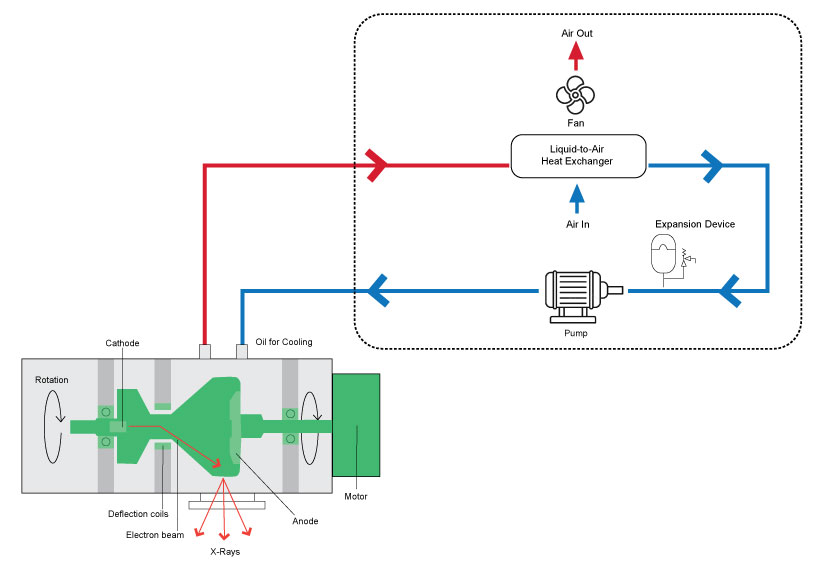
Liquid flow in a typical cooling system for medical X-ray equipment
Laird Thermal Systems Custom Solutions
Liquid cooling systems offer a high coefficient of performance (COP) that delivers efficient, low power operation to maximize uptime and optimize performance of medical X-ray imaging equipment. This efficiency optimizes heat transfer delivery away from thermally sensitive components to the ambient environment.
A liquid cooling system offers higher efficiency than air-based heat exchangers and provides more rapid cooling, quieter operation, higher reliability, and increased system uptime. Compared to conventional air heat transfer mechanisms, liquid cooling systems offer cooling up to 5X higher per square area. Laird Thermal Systems’ liquid cooling systems feature high thermal conductivity of coolants to remove bulk heat in Kilowatts with rapid cool down.
Since medical X-ray equipment features many unique cooling challenges, a custom liquid cooling system configuration is often required to optimize performance and long-life operation. The type of coolant used will depend on the desired control temperature. Laird Thermal Systems has the experience to design cooling systems that are compatible with water, water-glycol, dialectric oil or various corrosion inhibitors. Liquid cooling systems can also be quite complex and require temperature control of multiple liquid circuits or multiple pressure drop settings in order to accommodate low and high-pressure conditions. From simple cooling systems to complex and precise temperature control systems with multiple liquid circuits or multiple pressure drop settings, Laird Thermal Systems offers dynamic solutions that meet medical X-ray application requirements. They offer engineering design services with a global presence that supports onsite concept generation, thermal modeling, mechanical and electrical design and rapid prototyping. The company also offers validation test services to meet unique compliance standards for the medical industry.
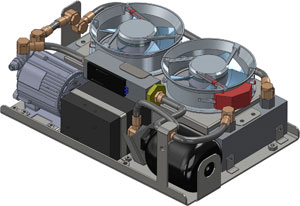
Because medial X-ray equipment features many unique cooling challenges, a custom liquid cooling system may be the optimal solution.
Liquid Cooling System Pump
Laird Thermal Systems has developed a spindle screw pumps featuring a simple construction that is ideal for high vibration, high G-force applications like rotational medical X-ray equipment. Compared to centrifugal pumps, spindle screw pumps provide higher reliability, performance and efficiency for liquid cooling systems. The fluid delivered by a screw pump does not rotate radially, but moves linearly. The rotors work like endless pistons, which continuously move forward. Flow through a screw pump is axial and in the direction of the power rotor. The inlet hydraulic coolant that surrounds the spindles is trapped as the spindles rotate. The coolant is pushed uniformly with the rotation of the spindles along the axis and is forced out the other end. This results in reduced power consumption, higher efficiency and a smaller motor size. It also enables the spindle screw pump to move fluids of higher viscosity without losing flow rate, and pressure changes have little impact on spindle screw pumps. Vital to the performance of rotating applications like a CT scanner gantry system, screw pumps are able to maintain constant flow and pressure while under high stress caused by high g-forces.
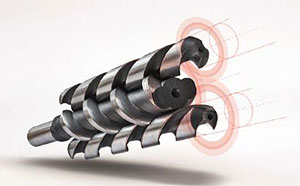
Long life operation is built into the spindle screw design due to no metal-to-metal contact between moving components. This minimizes friction wear and abrasions that can cause cavitation. The flexible mechanical assembly allows the use of a smaller strainer with higher mesh size that extends maintenance intervals and reduces the overall cost of ownership. No metal-to-metal contact also results in the elimination of pulsations, even at high flow rates, making the unit very quiet during operation. The end result is smooth and quiet operation even at high revolution rates and pressure.
More information on Laird’s spindle screw pump technology can be found at /cn/thermal-technical-library/application-notes/spindle-screw-pump-technology-medical-cooling.
Conclusion
Thermal management of medical X-ray systems is challenging due to the spinning gantry, increasing power densities and shrinking form factors. Heat must be quickly and efficiently moved away from temperature sensitive components inside the gantry system to ensure high quality imaging to detect and diagnose injuries and diseases. Laird Thermal Systems’ custom liquid cooling systems combine high heat pumping capacity and superior heat routing with lower power consumption, low noise operation and reduced footprints compared to competing technologies. With Laird Thermal Systems’ proprietary spindle screw pump technology, pressure changes have little impact on the liquid cooling system performance, as the pump easily moves fluids of higher viscosity without losing flow rate.
